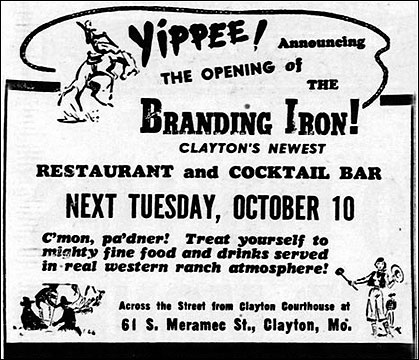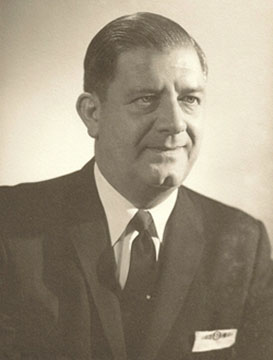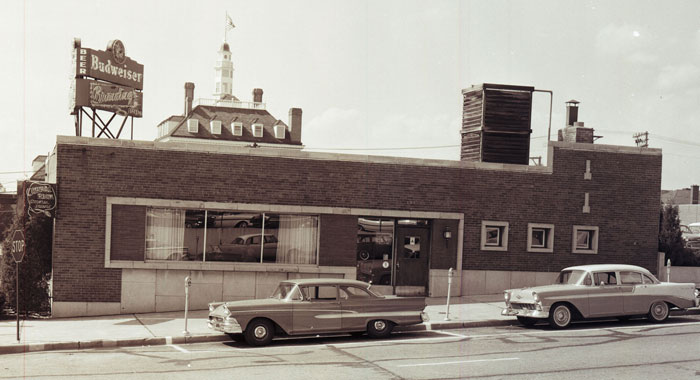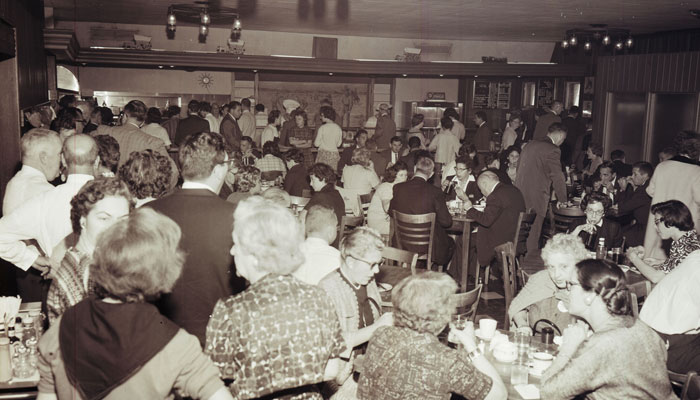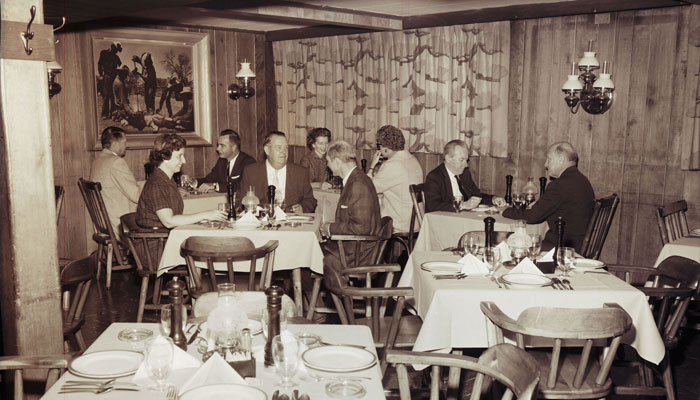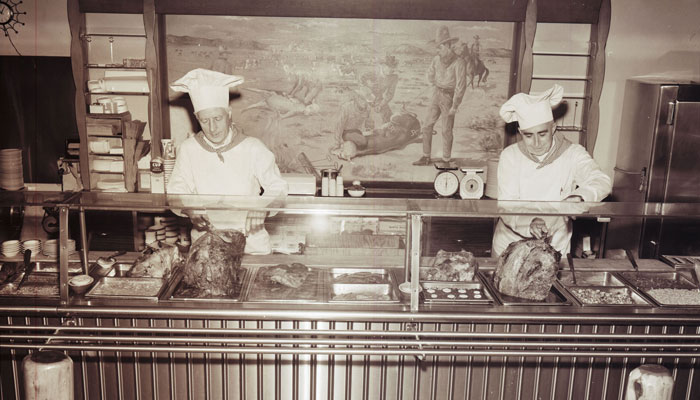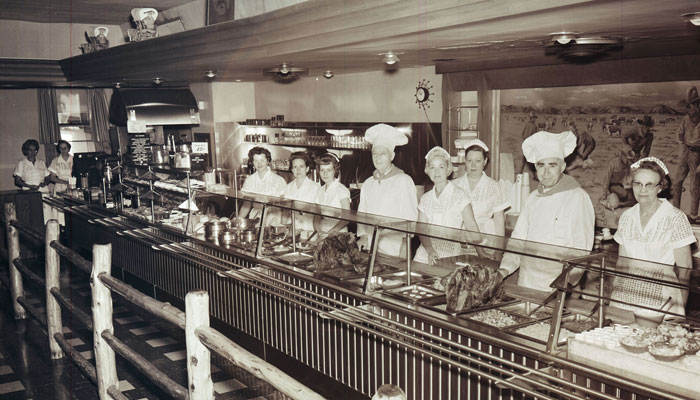|
Branding Iron In 1920, when the Prohibition law first became effective and liquor could no longer be served across long mahogany bars, those bars survived because of the free lunches they served. While the lunches didn't remain free, with no liquor to lead the loss, they soon became the long mahogany bar's stock in trade. Many became famous; St. Louis boasted Garavelli on DeBaliviere. But the city of Clayton, which was farmland in Prohibition days, had to wait until the middle of the century.
A contemporary styled brick and Bedford stone
building replaced a clutter of old frame structures. It was designed
by Bernard McMahon, a world-renowned architect who designed
commercial buildings and homes throughout Clayton, his hometown.
The Branding Iron restaurant opened on October 10, 1950, across the street from the St. Louis County Courthouse. It was initially operated by the J. & R. Mercantile Company and its president, Raymond E. Muckerman. However, by 1954, Harold Plengemeier, an operating partner in the firm, was the sole owner of the restaurant.
Harold B. Plengemeier grew up in St. Louis'
Dogtown neighborhood. He was drafted into the Army in World War II
and served as a cook on a base in Little Rock, Arkansas. He became a
cook at the Miss Hulling's Cafeteria downtown and was eventually
promoted to manager and food buyer.
The
squatty Branding Iron building had a large Budweiser
sign on its roof. When it was built, it
was architecturally well suited for 1950s Clayton; the bank building
at the other end of the block was squatty too. The county courthouse
was about all there was of the government center and there
were a few stubby office buildings around the business
district. But then Clayton changed. Glass and concrete and steel structures shot up all over. The bank mushroomed into a multistory facility. The government center spread into a two block behemoth. The Seven-Up company took over most of the block to the south. And the Branding Iron still squatted on the corner of Meramec and Carondelet.
The Branding Iron was actually two eating
establishments – a street-level cafeteria and the Corral Room, a sit-down restaurant and bar in
the basement. Entering the
cafeteria, with its western decor, was like entering a time warp. Wagon-wheel light fixtures
hovered over well-worn wooden tables and chairs. A couple of pairs
of steer horns, along with an assortment of branding irons, adorned
the walls.
Lawyers, jurors, judges and even a few criminals from the nearby county
court lined up at the Branding Iron for lunch, and as Clayton grew,
more corporate types joined them. Evenings brought multigenerational
families for dinner.
The finest carved roast beef, with bread
drenched in real gravy, was a favorite, as were the fillet of sole
sandwiches with real tartar sauce and the chicken fried steak with
cream gravy. Customers raved about the creamed spinach and the
mashed potatoes and gravy. In a mural behind the steam tables, cowboys wrestled a
Hereford calf to the ground. Regular customers knew the cafeteria's specials by heart – fried chicken on Wednesday, sauerbraten with potato pancakes on Thursday, and cod and jack salmon on Friday. Many topped off the calorie-rich meals with homemade fruit or cream pies.
When restaurants selling alfalfa-sprout
sandwiches and quiche invaded the business district to cater to the trendy set, the cafeteria's menu remained unchanged. Eating at the
Branding Iron was like going home for lunch; you knew what was in
the refrigerator before you opened the front door. And there was a
certain comfort in that.
In the early 1980s, Harold B. Plengemeier's sons, Harold W. and David, took over the restaurant's operation from their father. In 1984, they gave the establishment a minor facelift, but they were careful not to do too much. They didn't want to change their image; they had to make the right decisions since they planned to be there for the rest of their lives. But without fanfare or farewell, the Branding Iron closed for good after serving lunch on Tuesday, July 28, 1992, leaving a loyal clientele searching for alternatives to its mom-and-pop fare. Harold W. Plengemeier died of cancer on April 5, 1994 at the age of 50, perhaps explaining the abrupt closing. The property was sold to Commerce Bank. Harold B. Plengemeier died in 2006 at the age of 88. "He was very congenial – he had a lot of friends through the business," said his son David. "Everybody in Clayton knew who he was." Everyone in Clayton, and many beyond, also knew the Branding Iron.
Copyright © 2018 LostTables.com |



